Module4Carnival教案外研版必修5(精)教案.doc
外研版高中英语必修5教案 Module 4 Carnival

Module 4 Carnival 教案Period Four Cultural corner & Reading in workbookP87 Step 1 Lead inStep 2 Fast ReadingRead the passage quickly and put the main ideas of the five paragraphs into the right order.( ) The slave trade brought millions of black people to the new world.( ) We can understand what carnival is all about by reading the history of America and the meeting of two cultures.( ) Carnival became a celebration of freedom.( ) As time went on, carnival became a way of uniting different communities and now it has become a celebration of life itself.( ) The slaves were forced to watch their European masters to celebrate carnival and then they began to hold carnival with their own features.Step 3 Careful ReadingRead the passage again and choose the best answer.1. A larger number of slaves were taken to America because ___________.A. they had to make a living thereB. large farms need labor force in AmericaC. there were no labor force in AmericaD. America was richer than Africa2. Walking around a village with masks and singing songs means _______ in Africantraditions.. A. they are in high spirits B. they have got something goodC. that will bring them good luckD. to frighten ghosts away3. Nowadays carnival means______________A. remembering the pastB. honoring the harvestC. drinking, dancing, eating etc.D. uniting of different communitiesStep 4 Consolidation1. The arrival of Europeans in America, and the opening of huge farms and plantationsto grow cotton, fruit and vegetables, meant________________________(急需)for people to work on them.lions of people ________________(被强行带走)from their homes in Africa and ________(运送) to the New World to________________(当奴隶) .3.When the slave trade _____________(被废除)in 1838 the former slaves ____________(沿袭了)the carnival.4.They painted their faces white, _________(模仿)their masters and ________ _______ ______(取笑) them.5._________________________(随着时间的流逝), the white inhabitants of the islands began to ________ _________ ________(加入) the carnival, too.Step 4 Post-readingRead the passage “Christmas Traditions” in the workbook on page 87 and finish doing activities 7&8.Step 5 Discussion: Describing a Chinese festival (eg: the Spring Festival)Work in groups. Choose a Chinese festival. Discuss with things and write notes:●where and when it is celebrated●what happens during the festival●costumes and foodStep 5 HomeworkWrite a description of the festival for visitors to China.。
外研社必修五module4carnival全单元教案
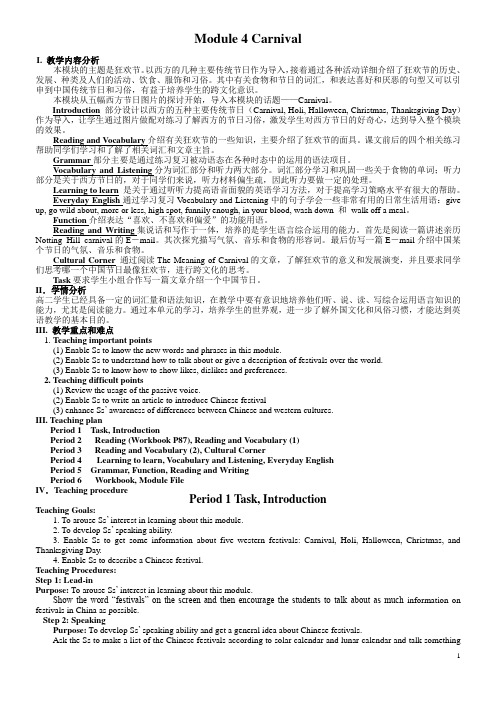
Module 4 CarnivalI. 教学内容分析本模块的主题是狂欢节。
以西方的几种主要传统节日作为导入,接着通过各种活动详细介绍了狂欢节的历史、发展、种类及人们的活动、饮食、服饰和习俗。
其中有关食物和节日的词汇,和表达喜好和厌恶的句型又可以引申到中国传统节日和习俗,有益于培养学生的跨文化意识。
本模块从五幅西方节日图片的探讨开始,导入本模块的话题——Carnival。
Introduction 部分设计以西方的五种主要传统节日(Carnival, Holi, Halloween, Christmas, Thanksgiving Day)作为导入,让学生通过图片做配对练习了解西方的节日习俗,激发学生对西方节日的好奇心,达到导入整个模块的效果。
Reading and Vocabulary介绍有关狂欢节的一些知识,主要介绍了狂欢节的面具。
课文前后的四个相关练习帮助同学们学习和了解了相关词汇和文章主旨。
Grammar部分主要是通过练习复习被动语态在各种时态中的运用的语法项目。
Vocabulary and Listening分为词汇部分和听力两大部分。
词汇部分学习和巩固一些关于食物的单词;听力部分是关于西方节日的,对于同学们来说,听力材料偏生疏,因此听力要做一定的处理。
Learning to learn是关于通过听听力提高语音面貌的英语学习方法,对于提高学习策略水平有很大的帮助。
Everyday English通过学习复习Vocabulary and Listening中的句子学会一些非常有用的日常生活用语:give up, go wild about, more or less, high spot, funnily enough, in your blood, wash down 和walk off a meal。
Function介绍表达“喜欢、不喜欢和偏爱”的功能用语。
Reading and Writing集说话和写作于一体,培养的是学生语言综合运用的能力。
外研版高中英语必修5《Module 4 Carnival》word教案
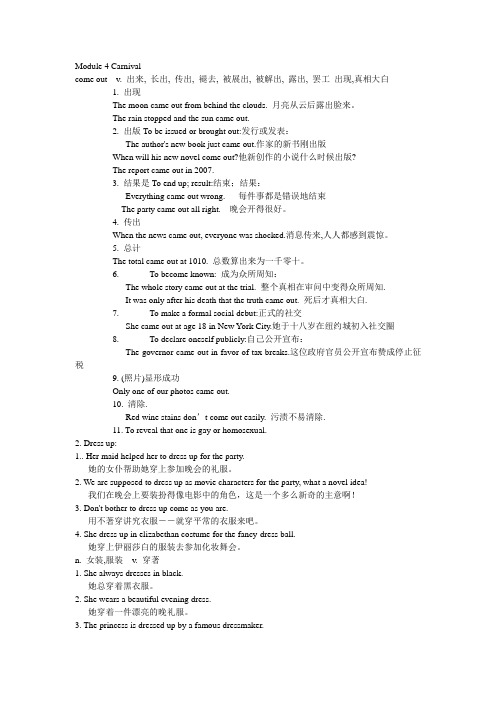
Module 4 Carnivalcome out v. 出来, 长出, 传出, 褪去, 被展出, 被解出, 露出, 罢工出现,真相大白1. 出现The moon came out from behind the clouds. 月亮从云后露出脸来。
The rain stopped and the sun came out.2. 出版To be issued or brought out:发行或发表:The author's new book just came out.作家的新书刚出版When will his new novel come out?他新创作的小说什么时候出版?The report came out in 2007.3. 结果是To end up; result:结束;结果:Everything came out wrong. 每件事都是错误地结束The party came out all right. 晚会开得很好。
4. 传出When the news came out, everyone was shocked.消息传来,人人都感到震惊。
5. 总计The total came out at 1010. 总数算出来为一千零十。
6. To become known: 成为众所周知:The whole story came out at the trial. 整个真相在审问中变得众所周知.It was only after his death that the truth came out. 死后才真相大白.7. To make a formal social debut:正式的社交She came out at age 18 in New York City.她于十八岁在纽约城初入社交圈8. To declare oneself publicly:自己公开宣布:The governor came out in favor of tax breaks.这位政府官员公开宣布赞成停止征税9. (照片)显形成功Only one of our photos came out.10. 清除.Red wine stains don’t come out easily. 污渍不易清除.11. To reveal that one is gay or homosexual.2. Dress up:1.. Her maid helped her to dress up for the party.她的女仆帮助她穿上参加晚会的礼服。
高二外研版必修5 Module 4 Carnival教案
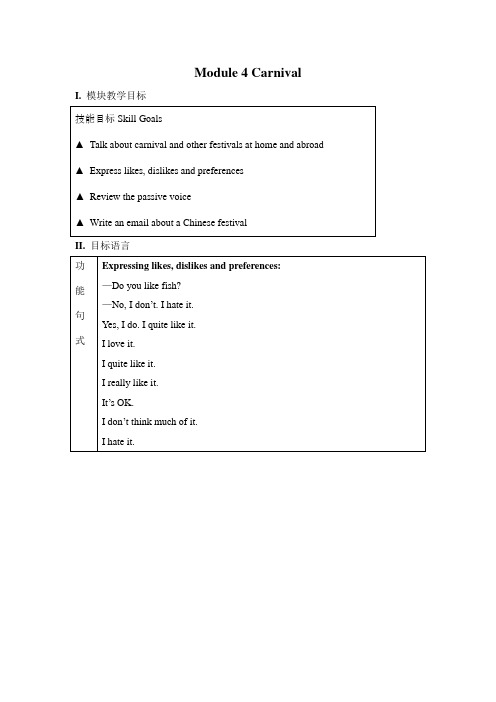
Module 4 Carnival I. 模块教学目标II. 目标语言Ⅲ.教材分析与教材重组1. 教材分析本模块以Carnival为话题,介绍狂欢节的历史、发展、种类及人们的活动、饮食和习俗,并由此引导学生联想、讨论中国的节日,旨在通过学习本模块使学生掌握有关节日和食物的词汇、句型,从而不但了解外国的狂欢节,而且对我国的节日也有进一步了解,进而拓展社会文化背景、增加跨国文化知识;使学生巩固表达喜好的方式,复习并掌握被动语态的用法;能够根据要求描写一个中国的节日,能表达自己的观点和想法。
1.1 INTRODUCTION Speaking 以五幅关于外国著名节日的图片和它们的简要描述切入话题,使学生通过讨论激活关于节日话题的背景知识,了解这五个著名节日的习俗及意义,以激起学生的学习兴趣; 第二个活动引导学生列出中国节日的名称和日期; 第三个活动以一幅图画和几个问题引导学生回顾节日期间的特殊着装; 第四个活动是选出节日期间做的事情,为本模块的学习作好铺垫。
1.2 READING AND VOCABULARY 课文以Carnival为话题,介绍了狂欢节的由来和发展、威尼斯狂欢节和美洲狂欢节的特点及异同。
通过课文前后的四个相关练习,使学生了解、学习相关词汇和课文主旨。
与课文相关的练习:Task 1是要求学生浏览课文后选出文中涉及话题,潜移默化中培养学生skimming 这一重要阅读技巧;Task 2是考察对文章细节的理解,有助于学生从微观的角度来理解课文;Task 3 && 4词汇、短语练习,找出文中一些较为复杂的词汇和短语的解析,从而为近一步的阅读理解扫除障碍。
1.3 GRAMMAR (Review of the passive voice) 通过一系列语法练习,旨在使学生复习并掌握被动语态在各种时态中的使用。
1.4 VOCABULARY AND LISTENING 该部分有两项任务,一是复习关于食物的一些词语,为下一步的听力作铺垫。
外研版必须5 Module 4 Carnival Reading 教学设计

高中英语外研版必修5 Module 4 CarnivalThe Magic of the Mask 阅读课教学设计一、课标分析 Curriculum Standard Analysis《普通高中英语课程标准》指出:高中阶段的阅读课教学目的是“培养阅读策略,培养语感,特别强调培养学生在阅读过程中获取和处理信息的水平。
”它还明确要求高中学生要具备以下阅读技能———即:略读( skimming) 、找读( scanning) 、预测上下文、理解大意、分清文章中的事实和观点、猜测词义、推理判断、了解重要细节、理解文章结构、理解图表信息、理解指代关系、理解逻辑关系、理解作者意图、评价阅读内容。
我认为如果教师能有计划、分步骤地对学生实行阅读理解技能的训练和阅读水平的培养,那么阅读课的教学便能够收到事半功倍的效果。
二、教材分析 Teaching Material Analysis(一)内容分析本模块以Carnival为话题,介绍狂欢节的历史、发展、种类及人们的活动、饮食和习俗,并由此引导学生联想、讨论中国的节日。
经过对教材内容的分析和重组,本模块可我分五课时教授:第一课时 Introduction, Reading and Vocabulary (1)第二课时 Reading and Vocabulary (2), Cultural Corner第三课时Learning to learn, Vocabulary and Listening, Everyday English第四课时 Grammar, Function, Reading and Writing第五课时 Workbook, Module File本节课是此模块的第一课时,是一节阅读课,在本模块的教学过程中起着重要的作用。
本节课主要向大家介绍狂欢节,这个话题与我们的日常生活和学生们感兴趣的外国文化有着很大的联系,对此话题的学习与讨论有益于提升学生学习英语的兴趣,通过日常教学使学生们掌握相关节日的新词汇,并使他们了解其它国家的文化背景和社会风貌,为学生以后的阅读和学习做好知识储备。
外研版高中英语必修五Module 4CarnivalReading教案4
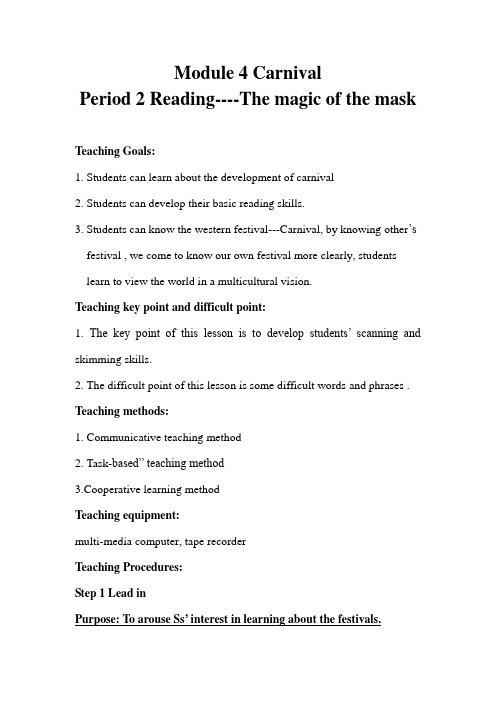
Module 4 CarnivalPeriod 2 Reading----The magic of the maskTeaching Goals:1. Students can learn about the development of carnival2. Students can develop their basic reading skills.3. Students can know the western festival---Carnival, by knowing other’s festival , we come to know our own festival more clearly, students learn to view the world in a multicultural vision.Teaching key point and difficult point:1. The key point of this lesson is to develop students’ scanning and skimming skills.2. The difficult point of this lesson is some difficult words and phrases . Teaching methods:1. Communicative teaching method2. Task-based” teaching method3.Cooperative learning methodTeaching equipment:multi-media computer, tape recorderTeaching Procedures:Step 1 Lead inPurpose: To arouse Ss’ interest in learning about the festivals.1. Ask Ss to name some chinese festivals.2. Small discussion:Which one is your favorite Chinese festival?3. Ask Ss to name the foreign festivals in the pictures.Step 2 ReadingPurpose: To develop some basic reading skills and get some information about carnival.Task1. Listen to the tape and choose the topics of the text.Task 2. Skim the text and match the topics with the paragraphs.Task 3. Scan the text and answer the detailed questions.Task 4. Read the text carefully and fill in the blank.Task 5. Test about the readingStep 3 Key pointsPurpose: This step is a practice section, aims to demonstrate their own ability of using language to do things.1.Think of carnival, and you think of crowds, costumes, and confusion.2.In Europe, where it began , carnival was followed by forty dayswithout meat,as people prepared for the Christian festival of Easter.3.Having fun meant eating ,drinking and dressing up.4.Ordinary people could pretend to be rich and important, while famouspeople could have romantic adventures in secret .Step 4 Retelling the textPurpose: Enable Ss to learn about the details of text and help them to talk about carnival. Let them to know what they have learnt during the class.Step 5 Homework1.Activity 3 on P32 and Activity 4 on P33.2.Finish V ocabulary exercises in WB .。
高中英语外研版高中必修5Module4Carnival-我的教案
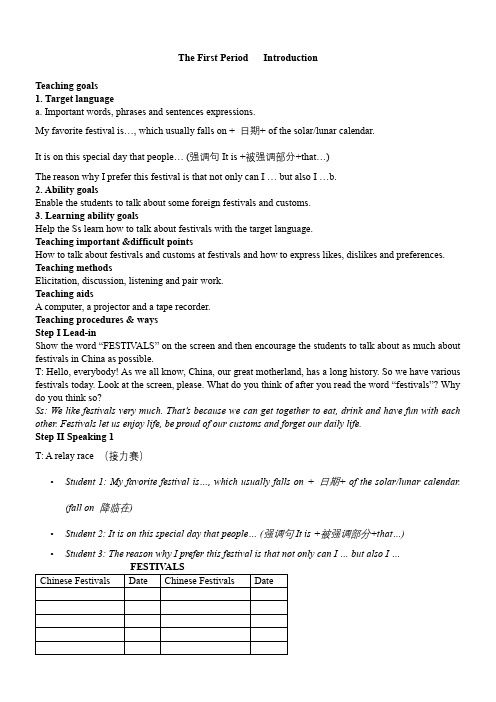
The First Period IntroductionTeaching goals1. Target languagea. Important words, phrases and sentences expressions.My favorite festival is…, which usually falls on + 日期+ of the solar/lunar calendar.It is on this special day that people… (强调句It is +被强调部分+that…)The reason why I prefer this festival is that not only can I … but also I …b.2. Ability goalsEnable the students to talk about some foreign festivals and customs.3. Learning ability goalsHelp the Ss learn how to talk about festivals with the target language.Teaching important &difficult pointsHow to talk about festivals and customs at festivals and how to express likes, dislikes and preferences. Teaching methodsElicitation, discussion, listening and pair work.Teaching aidsA computer, a projector and a tape recorder.Teaching procedures & waysStep I Lead-inShow the word “FESTIV ALS” on the screen and then encourage the students to talk about as much about festivals in China as possible.T: Hello, everybody! As we all know, China, our great motherland, has a long history. So we have various festivals today. Look at the screen, please. What do you think of after you read the word “festivals”? Why do you think so?Ss: We like festivals very much. That’s because we can get together to eat, drink and have fun with each other. Festivals let us enjoy life, be proud of our customs and forget our daily life.Step II Speaking 1T: A relay race (接力赛)•Student 1: My favorite festival is…, which usually falls on + 日期+ of the solar/lunar calendar.(fall on 降临在)•Student 2: It is on this special day that people… (强调句It is +被强调部分+that…)•Student 3: The reason why I prefer this festival is that not only can I … but also I …S3: That’s also called the Lantern Festival. It’s the 15th day of the first lunar month, when we eat special sweet dumplings called Yuanxiao and enjoy displayed lanterns. And we enjoy beautiful fireworks, too.T: You have done a good job. What are the other festivals?S4: International Women’s Day. It is on March 8.S5: Arbor Day on March 12th.S6: International Labor Day and Chinese Youth Day.S7: International Children’s Day.T: Yes. Do you know other Chinese festivals?S8: Army Day is on August 1st and Teachers’ Day is on September 10th.S9: National Day on October 1st.T: Excellent work! Those are mostly the legal holidays in our country. There are also some traditional Chinese festivals celebrated according to the lunar calendar. Do you know some other traditional festivals? List some of them, please.S10: Qingming Festival in memory of the dead or the heroes on April the fifth.T: It’s called Tomb Sweeping Festival. Another one?S11: Dragon Boat Festival on the fifth day of the fifth lunar month in memory of the great poet - Qu Yuan. S12: Mid-Autumn Festival on the fifteenth day of the eighth lunar month.T: You’ve done a good job, boys and girls! You have named so many festivals. I’m proud of you for youT: Ok! We have got lots of information about Chinese festivals. Would you like to know something about some foreign festivals?Ss: Yes! Of course!T: What’s the most important festival in western countries?Ss: Christmas!T: That’s right! Please look at the pictures on page 31, and then match the festivals with the descriptions. If you know some information about the festivals, please talk about them with your partners.S1: Christmas is both a legal and religious holiday, which observes the anniversary of the birth of Jesus. All states and all those of the Christian faith celebrate this holiday on which people give each other presents and best wishes while the children believe that the presents come from Father Christmas. So I think the first description can be matched with the festival of Christmas.S2: Yes. I can’t agree with you more. I guess Holi is a festival with color, which marks the beginning of spring in India. That’s because the people in the picture are colored heavily. But I know no more about it. T: That’s Ok. The festival of Holi is celebrated on the day after the full moon in early March every year. Apart from the usual fun with colored powder and water, Holi is marked by vibrant processions that are accompanied by folk songs, dances and a general sense of abandoned vitality. Who’d like to say something else about other festivals and their descriptions?S3: There is so much delicious food on Thanksgiving Day, so it must be when Americans remember the hard times when they first arrived in the country. T: The food is turkey(火鸡), corn and pumpkin pies(南瓜派). Thanksgiving Day is a traditional American festival on the fourth Thursday in November, when families get together and have a big dinner. How about the next one?S4: Judging from the pictures, there are two festivals for which people love wearing special clothes. So I’m not sure which one is suitable for the description.S5: Have you paid attention to the fifth description? I’m sure Halloween(万圣节) is the festival at the end of October, when “ghosts” come out, for it’s said that witches (女巫) ride through the air on broomstick. T: Yes! Halloween is a time to have fun and it comes on October 31st. It’s one of the most favorite holidays for children. Parties are very popular, too. People wear scary clothes and masks(面具), for example, dress up like a witch(巫婆).S6: Then for Carnival people love wearing special clothes and it seems that people usually dress up and wear a mask at this festival.T: That’s true. People walk on the street wearing masks, doing what they want to do without being recognized. Look at the picture lower in this page. What is the person wearing?S7: The person is wearing so special clothes and a mask that it’s hard to say it is male or female.T: Have you ever dressed up in special clothes?Ss: No. At the Spring Festival we usually wear beautiful and new clothes but there are no special clothes. Maybe the Chinese minorities wear special clothes on their festivals.T: Yes. As we all know, different countries have different culture and social customs. Then what do you usually do during festivals? Let’s come to part four of this page, and please check out the thing you do.S8: We eat special food at different festivals. For example, on Mid-Autumn Day we usually eat moon cakes and other delicious food, Zongzi is the traditional food for the Dragon Boat Festival and jiaozi for the Spring Festival.S9: We give and receive gifts, have holidays from school and enjoy ourselves with friends and family at the Spring Festivals. On Lantern Festival and the Dragon Boat Festival we take part in different traditional ceremonies, such as enjoying displayed lanterns, rowing dragon boats and so on. S10: We sometimes dance and listen to music at festivals, but usually we enjoy all kinds of entertainment programs.T: I am very proud of you because you know so much about festivals at home and abroad.Step IV Read and repeatMy favorite festival is the spring festival, which falls on January 1st of the lunar calendar. It is on this special day that my family get together and have a big dinner. My father will put up couplets while I will set off firecrackers. The reason why I prefer this festival is that not only can I get the lucky money on this day but also I can enjoy a long and relaxing holiday.Step V Summary and homeworkT: Boys and girls you did very well today. We have talked about festivals around the world, so I believe all of us have broadened our horizon. Here is your homework today: If you have a chance to decide a newholiday that is most likely to be necessary in your opinion, please create a new holiday and give your reasons.。
外研版必修5 Module4教案

外研版必修5 Module4教案Module Four CarnivalPeriod OneTeaching content:Introduction & Reading and VocabularyTeaching important points:1.Learn some new words and phrases about carnival.2.Help the students understand the passage and learn about carnival better.3.Help the students learn some difficult language points.4.Train the students` reading skill.Teaching difficult points:1.Help them make sense of the new words and phrases.2.Help them improve reading ability and understand the passage better.3.Help them master language points in this passage.Teaching procedures:Step 1 Lead-inWhen we were children,we all looked forward to festivals.Why?Because festivals mean eating delicious food,wearing beautiful clothes,visiting relatives,getting red envelopes,doing what we want to do and so on.In aword,festivals mean happy time.This module,we will talk about thetopic:Carnival.Step 2 Introduction1.Activity 2 on P31Now please name some Chinese festivals and say when they are celebrated.春节:The Spring Festival(Lunar January 1)元宵节:The Lantern Festival(Lunar January 15)清明节:Ching Ming Festival/Tomb-sweeping Day(Solar April 4-6)端午节:Dragon Boat Festival(Lunar May 5)七夕节:Double Seventh Festival(Lunar July 7)中秋节:Mid-Autumn Festival(Lunar August 15)重阳节:Double Ninth Festival(Lunar September 9)除夕:New Year` Eve(Lunar December 31)【清明节】清明是我国的二十四节气之一。
外研版高中英语必修五Module 4CarnivalReading教案4

Module 4 CarnivalPeriod 2 Reading----The magic of the maskTeaching Goals:1. Students can learn about the development of carnival2. Students can develop their basic reading skills.3. Students can know the western festival---Carnival, by knowing other’s festival , we come to know our own festival more clearly, students learn to view the world in a multicultural vision.Teaching key point and difficult point:1. The key point of this lesson is to develop students’ scanning and skimming skills.2. The difficult point of this lesson is some difficult words and phrases . Teaching methods:1. Communicative teaching method2. Task-based” teaching method3.Cooperative learning methodTeaching equipment:multi-media computer, tape recorderTeaching Procedures:Step 1 Lead inPurpose: To arouse Ss’ interest in learning about the festivals.1. Ask Ss to name some chinese festivals.2. Small discussion:Which one is your favorite Chinese festival?3. Ask Ss to name the foreign festivals in the pictures.Step 2 ReadingPurpose: To develop some basic reading skills and get some information about carnival.Task1. Listen to the tape and choose the topics of the text.Task 2. Skim the text and match the topics with the paragraphs.Task 3. Scan the text and answer the detailed questions.Task 4. Read the text carefully and fill in the blank.Task 5. Test about the readingStep 3 Key pointsPurpose: This step is a practice section, aims to demonstrate their own ability of using language to do things.1.Think of carnival, and you think of crowds, costumes, and confusion.2.In Europe, where it began , carnival was followed by forty dayswithout meat,as people prepared for the Christian festival of Easter.3.Having fun meant eating ,drinking and dressing up.4.Ordinary people could pretend to be rich and important, while famouspeople could have romantic adventures in secret .Step 4 Retelling the textPurpose: Enable Ss to learn about the details of text and help them to talk about carnival. Let them to know what they have learnt during the class.Step 5 Homework1.Activity 3 on P32 and Activity 4 on P33.2.Finish V ocabulary exercises in WB .。
外研版高二英语必修5Module4Carnival教案
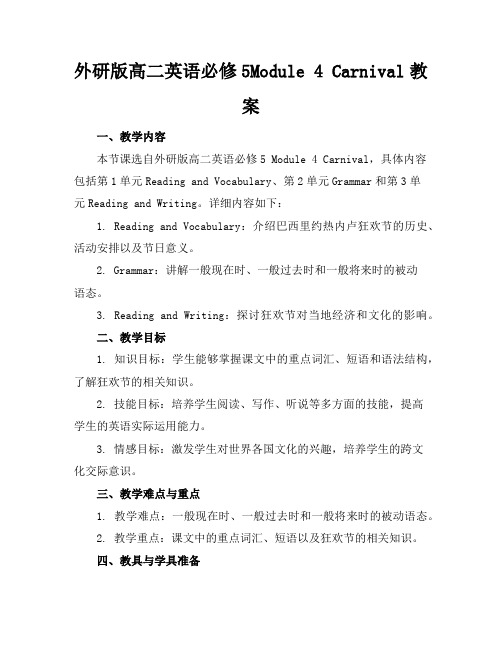
外研版高二英语必修5Module 4 Carnival教案一、教学内容本节课选自外研版高二英语必修5 Module 4 Carnival,具体内容包括第1单元Reading and Vocabulary、第2单元Grammar和第3单元Reading and Writing。
详细内容如下:1. Reading and Vocabulary:介绍巴西里约热内卢狂欢节的历史、活动安排以及节日意义。
2. Grammar:讲解一般现在时、一般过去时和一般将来时的被动语态。
3. Reading and Writing:探讨狂欢节对当地经济和文化的影响。
二、教学目标1. 知识目标:学生能够掌握课文中的重点词汇、短语和语法结构,了解狂欢节的相关知识。
2. 技能目标:培养学生阅读、写作、听说等多方面的技能,提高学生的英语实际运用能力。
3. 情感目标:激发学生对世界各国文化的兴趣,培养学生的跨文化交际意识。
三、教学难点与重点1. 教学难点:一般现在时、一般过去时和一般将来时的被动语态。
2. 教学重点:课文中的重点词汇、短语以及狂欢节的相关知识。
四、教具与学具准备1. 教具:多媒体课件、黑板、粉笔。
2. 学具:教材、笔记本、字典。
五、教学过程1. 导入:通过展示巴西里约热内卢狂欢节的图片和视频,引发学生对狂欢节的兴趣,为新课的学习做好铺垫。
2. 阅读理解:学生自主阅读课文,完成相关练习,了解狂欢节的历史、活动安排和意义。
3. 语法讲解:教师讲解一般现在时、一般过去时和一般将来时的被动语态,并举例说明。
4. 例题讲解:分析教材中的例题,引导学生运用所学的语法知识进行改写句子。
5. 随堂练习:学生完成课堂练习,巩固所学知识。
6. 小组讨论:学生分组讨论狂欢节对当地经济和文化的影响,并进行汇报。
六、板书设计1. 课文Carnival2. 重点词汇:history、schedule、economy、culture3. 语法结构:被动语态(一般现在时、一般过去时、一般将来时)七、作业设计1. 作业题目:(1)用被动语态改写下列句子。
Module4Carnival教案外研版必修5(精)

Module 4 CarnivalPeriod OneTeaching aims:1. To revise Chinese and western festivals.2. To develop the students reading ability.3. To understand what is about Carnival.Important and difficult points:1 Get the students to understand the history of carnival.2 Get the students to describe the festivals in groups.Teaching procedures:Step 1. Revision.Read the new words of this passage.Step 2. Introduction1. We have learned many festivals both Chinese and the Western. What festivals do you know? Divide the class into 2 groups. One group is for Chinese Festivals, the other group is for Western festivals.Make a list of them on the blackboard..2. Turn to Page 31— Match the festivals with the description.Step 3. Lead-inToday we will learn another festival ---- Carnival. It originates from Europe, and during thesedays, people often love wearing special clothes and masks for it.Step 4. Fast-readingMatch the main idea with every paragraph.Paragraph 1 A meaning of carnival and how it was celebratedParagraph 2 B the law about wearing masksParagraph 3 C general impression of carnivalParagraph 4 D how it is celebrate today in Venice and the feature of it Paragraph 5 E carnival in Venice and the problem it causedParagraph 6 F the revival of the tradition of celebrating it.(Answers: 1— 6 CAEBFDStep 5. Further-readingRead the passage and answer the questions.1. Where does Carnival come from? What does it mean?2. When was it celebrated?3. Where was the most famous Carnival in Europe?4. How long did the first Carnival in Venice last? What about now?5. Did the government of Venice encourage the wearing of masks?6. Who started the Carnival again, tourists or students?(Answers: 1. “Carnival” comes from two Latin words, meaning “no more meat”. 2. It began just after Christmas. 3. The most famous carnival in Europe was in Venice. 4. At the beginning, it lasted for just one day. 5. No. 6. The students started the Carnival. Step 6. VocabularyActivity 1: Read through the words in the box and have the students repeat them individually. Ask the students to complete the task individually, then check with a partner. Check the answers together:(Answers: 1. confusion 2. excitement 3. mask 4. mystery 5. magic 6. costume 7. crowd 8. tradition 9. atmosphereActivity 2: Choose the correct meanings of the words and phrases.Check the answers one by one.(Answers: 1— 4 babb 5— 8 abbbStep 7. DiscussionDiscuss in groups of four.1. What is the feature of carnival in Venice?2. Which is your favourite festival?Step 8. Homework1. Workbook— on Page 87.Read the passage and match the headings with the text.2. Write a short passage about your favorite festival.Period TwoTeaching aims:1. To listen to the description about western customs.2. To express likes, dislikes and preferences:(1 I love doing…;(2 I don’t like…; I hate…; I dislike…; I don’t care much for(3 I prefer…to…; I prefer doing …(4 I’d rather…than…(5 I an interested in…3. To learn several phrases.Difficult and important points:1. Get the students to express likes and dislikes2. Learn to use the phrases: give up; go wild ;more or less; high spot; funnily enough; in your blood; wash down; walk offTeaching procedures:Step 1. RevisionCheck the homework.— Ask several students to read the short passage with the name of My Favorite Festival.Step 2. Vocabulary1. Read the words about food.2. Now say which things you eat at a festival.3. Practice.Activity 2: Find these things in the box in Activity 1.(1 Two type of meat ((2 a food that consists of a tube of skin containing meat mixed with herbs. ((3 five vegetables ((4 two ingredients for making a cake ((Answers: (1 pork and chicken (2 sausages (3 beans, cabbages, garlic, onion, peas (4 flour, eggsStep 3. ListeningBefore listening— Look at the photos in Activity 4 and tell them every picture meaning a special festival..While listening— Listen to the tape twice and match the names of the festivals with the photos.After Listening:Complete the tableStep 4. Everyday English1. Read the sentences and choose the correct meaning of the words and phrases.2. Check the answers one by one. (1-b (2 a (3 b (4a (5 b (6 a (7a (8b3. Explain the words and phrases.(1give up sth. =don’t have it any more(2 go/wild with joy 欣喜若狂(3 more or less =approximately (oppositeexactly.Eg: That is approximately correct.(4 high spot= the best part(5 be/run in sb.`s blood = be /run in the blood. 生来就有的(因遗传或环境影响eg; Most of my family are teachers, it runs in the blood.(6 wash down a meal = have a drinkwalk off a meal = help the food go down by walking.Step 5. Function1. Match the sentences with the speakers. Say what they are speaking about.(1Caitlin: King Cake(2Maria: Feijoada(3 Stefan: saugages(4 Cameron: traditional Jamaican food – chicken with rice and peas.2. Number the phrases from the most negative to the most positive(1 Ask the students to do this individually.(2 Call the answers back from the whole class, one at a time, from 1--6(3 Write down them on the blackboard:3. Work in pairs. Discuss your preferences for food to eat at festival. Use the phrases in Activity2.(1 Read the example with the class.(2 Pair the students to discuss their preferences.(3 Circulate and monitor their production.Step 6. HomeworkFinish off the workbook.Period ThreeTeaching aims:1. To learn more about carnival.2. To teach them how to write an e-mail.3. To develop the students’ reading skills.Difficult and important points:1. Get the students to learn to write an e-mail.2. Get the students to understand some important sentences.Teaching procedures:Step 1. RevisionRead the words and have a dictation.Step 2. Lead-inWhat do you remember about carnival?Where did it start first?Step 3. Fast-reading:Read and underline the topic sentences ( use your own words about every paragraph. Paragraph1: We can understand what carnival is all about by reading the history of America and the meeting of two cultures.Paragraph2: The slave trade brought millions of black people to the new world. Paragraph3: The slaves were forced to watch their European masters to celebrate carnival and then they began to hold carnival with their own features.Paragraph4: Carnival became a celebration of freedom.Paragraph5: As time went on, carnival became a way of uniting different communities and now it has become a celebration of life itself.Step 4. Further reading1. What did marked the beginning of the slave trade?2. How were millions of people taken to work as slaves?3. How did the slaves begin to hold their own carnival in Trinidad?4. When was the slave trade abolished?5. How was carnival changed when the slave trade was abolished?6. When did carnival become a way to unite different communities?(Answers: 1 That the arrival of European in America, and the opening of huge farms and plantations to grow cotton, fruit and vegetables, meant there was an immediate need to people to work on them marked the beginning of the slave trades. 2 Millions of people were taken by force from their homes in America and transported to the New World to work as slaves? 3. They painted their faces white, imitating their masters and making fun of them. 4. The slave trade was abolished in 1838. 5. It became more colourful and more exciting than it had been before. 6. As people forgot their everyday problems and enjoyed themselves eating, drinking, and dancing.Step 5. Several phrases(1 by force (2 be forced to do (3make fun of sb. (4 bring good luck (5 take over (6 take part in (7 become a celebration of freedom (8 with the time passing Step 6. Discussion1. What is the meaning of carnival?2. Which Chinese festival is most like carnival?Step 7. Reading and writingActivity1. Read the email and number the things in the order you read them1. Read through the things with the whole class and make sure that they understand them all.2. Ask them to read the email and order the things individually, then check with a partner.3. Call back the answers from the whole class, in order.(Answers: 1. the atmosphere at the festival 2. the music 3. the food 4. what the writer’s doing5. what the writer’s going to doActivity2. Underline the adjectives used to describe.1. the atmosphere: noisy/ colourful2. the music: great/ exciting/ relaxing3. the food: good/ tastyActivity3 Write an email from a Chinese festival. Make sure of the details about:1. the atmosphere2. the music3. the foodStep 8. HomeworkWrite a description of the festival for visitors to China.( For example: Spring Festival Period FourTeaching aims:1. To learn new words and expressions and learn how to use them.2. To review of the passive voices.Difficult and important points:1. Get the students to know how to use passive voices:一般现在时和一般过去时的被动语态2. The usage of: hide, pretend, memory, wander, come to an end, dress up; consist of be good for ,date from.Teaching procedures:Step 1. RevisionRead the sentences and find out what grammar are they?1. Is the room cleaned every day?2. We were woken up by a loud noise during the night.3. Something must be done before it is too late.4. Have you heard the news? The President has been shot?5. The car was three years old but hadn’t been used very much.6. There’s somebody walking behind us. I think we are being followed.Step 2. Presentation—被动语态被动语态的基本形式是 : be +过去分词根据时态的不同 , be的形式有所变化 .(1 一般现在时的被动语态 : am/is /are+过去分词 (口语可用 get/become或 got /became(2 一般过去时的被动语态 :was /were+过去分词被动语态的基本用法 :不知道或没有必要提到动作的执行者是谁时用被动语态 . 强调或突出动作的承受者常用被动语态 .(有时可省略 .使用被动语态应注意的几个问题 .(1 主动变被动时双宾语的变化 . 看下列例句eg: 我朋友在我生日时送我一本有趣的书 .My friend gave me an interesting book on my birthday.— An interesting book was given to me (by my friend on my birthday.— I was given an interesting book (by my friend on my birthday.(2 主动变被动时 , 宾补成主补 (位置不变 ; 作宾补的省略 to 的不定时在被动语态中应加 to. eg: 老板让他整天工作 .The boss made him work all day long.— He was made to work all day long (by the boss.(3 短语动词变被动语态时 , 勿要掉”尾巴”.eg: 孩子们被他照顾的很好 .— The children were taken good care of ( by her.eg: 要注意一下你的发音和拼写 .— Your pronunciation and spelling should be paid attention to.(4 情态动词和 be going to, be to, be sure to ,used to, have to, had better等结构变被动语态 , 只需将它们后面的动词原形变为 be +过去分词。
高中英语外研版高中必修5Module4Carnival-教学设计

高中英语写作教学设计主题语境:人与社会——传统节日语篇类型:介绍性语篇教学内容分析和设计思路:本堂课的主题是“人与社会——传统节日”,涉及三个成型语篇,第一篇是关于印度传统节日Holi(胡里节)一篇说明文,第二篇是中国传统节日春节的风俗的一个听力语篇,第三篇是学生自己创作的介绍春节的语段组合成的一个语篇,主要目的是让学本堂课学到的东西能运用到写作中去。
本堂课的总体设计思路主要有三条线,第一:通过介绍印度传统节日Holi,让学生对介绍传统节日要素有所理解,知道如何向外国朋友介绍咱们中国的传统节日。
第二:通过对本堂课的学习,学生能积累一些描述春节的单词,短语和句型。
第三:通过对国中国传统节日的学习,深刻理解中国优秀的传统文化,让学生能成为中国文化的传播者。
学情分析:四川省南江县长赤中学地处农村,该班学生也都来自农村,相对于城市学生,他们英语的听、说、读、写的能力相对欠缺,尤其是听、说、写的能力,但是经过一年多时间的学习,孩子们的这些学科能力有所提高,本堂课也是基于他们的基础而设计的,可操作性强。
本堂课的目的是让他们积累关于春节的表达,掌握从哪些方面去介绍春节,进一步提升他们的写作能力和英语学科素养。
教学目标:学科素养:1.提取语篇大意,梳理文章结构。
2.明白介绍节日的基本要素,积累春节的相关表达,写一篇介绍春节的短文。
核心素养:深刻理解中国优秀的传统文化,培养优秀传统文化的自信。
教学重点:1.介绍节日的基本要素2.积累相关的表达教学难点:写好一篇介绍春节的文章和语言素养的提升。
教学方法:独立学习和合作探究。
教学反思:板书设计:B5M4 CarnivalReading and writingA festivalplace time meaning origin customs。
外研版高二英语必修5Module4Carnival教案
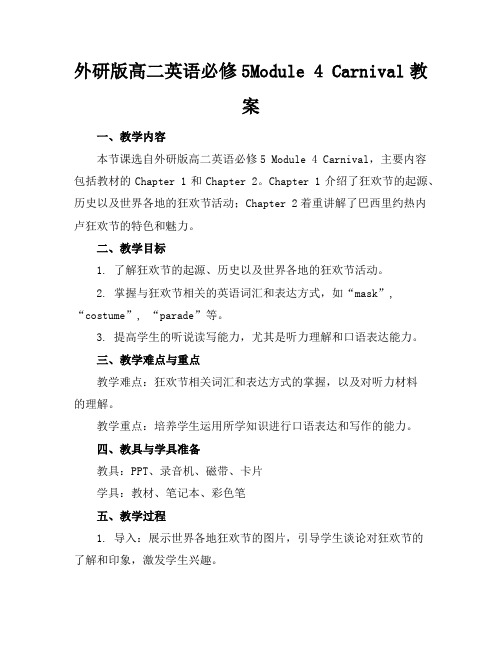
外研版高二英语必修5Module 4 Carnival教案一、教学内容本节课选自外研版高二英语必修5 Module 4 Carnival,主要内容包括教材的Chapter 1和Chapter 2。
Chapter 1介绍了狂欢节的起源、历史以及世界各地的狂欢节活动;Chapter 2着重讲解了巴西里约热内卢狂欢节的特色和魅力。
二、教学目标1. 了解狂欢节的起源、历史以及世界各地的狂欢节活动。
2. 掌握与狂欢节相关的英语词汇和表达方式,如“mask”, “costume”, “parade”等。
3. 提高学生的听说读写能力,尤其是听力理解和口语表达能力。
三、教学难点与重点教学难点:狂欢节相关词汇和表达方式的掌握,以及对听力材料的理解。
教学重点:培养学生运用所学知识进行口语表达和写作的能力。
四、教具与学具准备教具:PPT、录音机、磁带、卡片学具:教材、笔记本、彩色笔五、教学过程1. 导入:展示世界各地狂欢节的图片,引导学生谈论对狂欢节的了解和印象,激发学生兴趣。
2. 新课内容展示:a. Chapter 1:介绍狂欢节的起源、历史以及世界各地的狂欢节活动。
b. Chapter 2:讲解巴西里约热内卢狂欢节的特色和魅力。
3. 实践情景引入:分组讨论,让学生设想自己正在参加狂欢节,讨论如何准备和参与狂欢节。
4. 例题讲解:分析教材中的例句,讲解狂欢节相关词汇和表达方式。
5. 随堂练习:让学生运用所学知识进行口语表达和写作练习。
六、板书设计1. 狂欢节相关词汇和表达方式2. 巴西里约热内卢狂欢节特色七、作业设计1. 作业题目:以小组为单位,编写一篇关于狂欢节的短文,内容包括狂欢节的起源、历史、世界各地狂欢节活动以及自己参加狂欢节的设想。
2. 答案:学生完成作业后,教师进行批改,给予评价和建议。
八、课后反思及拓展延伸1. 反思:针对本节课的教学效果,教师应思考如何更好地激发学生的学习兴趣,提高课堂参与度。
2. 拓展延伸:鼓励学生课后了解更多关于狂欢节的文化背景,如观看相关纪录片、阅读英文文章等,提高学生的跨文化交际能力。
高中英语 Module4 Carnival学案 外研版必修5

高中英语 Module4 Carnival学案外研版必修5Carnival 学案核心词汇1、Now more and more schools are trying to____________(扩大)their school yards to admit more students、2、He ____________(假装)that he was ill so that he could stay at home、3、The United Kingdom____________(由……构成)of Great Britain and Northern Ireland、4、They will ____________(传递)passengers from Beijing to Shanghai、5、She was ____________(漫步)aimlessly up and down the road、6、She is in a state of mental ____________(错乱)、7、The ____________(宏伟的)scene of the waterfall is a perfect delight to the eyes、8、Hearing the news our failing spirits____________(振作)、9、Fishing is his favourite____________、He knows it helps to ______________ him and many people else also find fishing ____________ and they often wear a ____________ smile after catching a fish、(relax)10、We’d like to __________ his birthday and the ____________ will be held in the hall、(celebrate)1、extend2、pretended3、consists4、transport,5、wandering6、confusion7、magnificent8、revived9、relaxation;relax;relaxing;relaxed10、celebrate;celebration高频短语1、________________ 结束;完结2、________________ 装扮;打扮3、________________ 接手,接管4、________________ 由……组成;由……构成5、________________ 放弃6、________________ 过得愉快7、________________ 追溯到8、________________ 几乎,差不多;大约9、________________ 连续地;不断地10、________________ 秘密地;暗地里11、________________ 变得疯狂12、________________ 冲洗某物,冲下13、________________ 用暴力,迫使14、________________ 捉弄,取笑1ZZZe to an end2、dress up3、take over4、consist of,5、give up6、have fun7、date back to8、more or less9、on end10、in secret11、go wild12、wash、、、down13、by force14、make fun of重点句式1、________________,________ you think of crowds,costumes and confusion、想到狂欢节,你自然就会想起拥挤的人群,节日的服饰及混乱的场景。
高中英语外研版高中必修5Module 4 Carnival教学设计

必修5 Module 4 The magic of the mask- ReadingTeaching PlanTeaching aims1)To know more about the carnival2. Ability1)To improve reading ability,speaking and listening.2)To find the main idea of each paragraph and some details3. Mortal1) To strengthen the awareness of preserving Chinese traditional festivals.Teaching important and difficult points1. How to get the students to grasp the main idea and the key words of each section. Teaching methods:Task based teaching method, situational teaching method...Teaching assistant:PPTTeaching procedurePre-readingLead in1. Show some pictures to drive students’curiosity about the topic2.Lead students to describe the carnival by wet-chatting with Mr MaskWhile-reading1) Ask the students to read the passage quickly and match the main idea of paragraph (Individu al work)1. Match the main idea of each paragraph.A The origin of carnival and how it was celebrated in history.B The revival of the tradition of celebrating carnival.C The general impression of carnival.D Carnival in Venice.E The law about wearing masks.F The new carnival today in Venice and its feature.Para 1--- __C___ ②Para 2--- _A____③Para 3--- _D____ ④Para 4--- __E___⑤Para 5--- __B___ ⑥Para 6--- __F___1)Ask the students to read paragraph 1 for detailsPeople’s impression of carnival:Crowded Costumes Confusion2).Ask the students to read paragraph 3-6 and then finish the sentences about the development of Venice Carnival. (Pair work).Extension Activity(Group work)Do a game:Mask,Mask where to go?If you have a magical mask,Who do you want to pretend to be?What do you want to do?why? Moral lessonStrengthen the awareness of Chinese traditional festivals and get the belief that we will preserve our tradition and pass it down to next generation to makethe world better.Learning about the foreign culture makes us more conscious of our own.We should love our own culture.学习外国文化,能使我们对自己的文化有更清楚的认识。
(教师用书)高中英语 Module 4 Carnival教案 外研版必修5
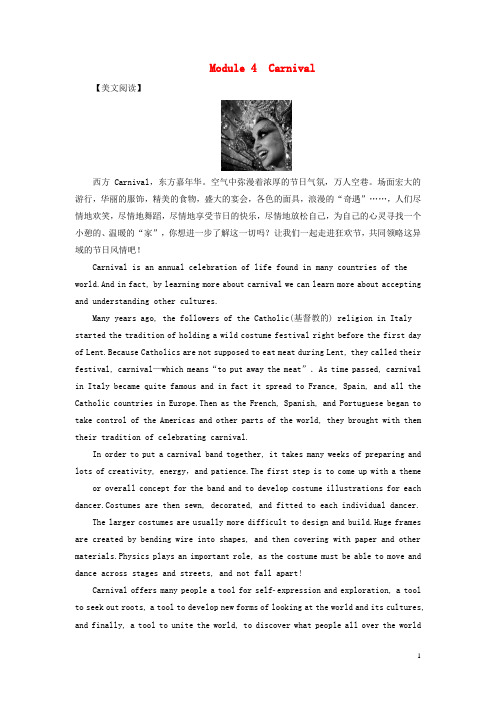
Module 4 Carnival【美文阅读】西方Carnival,东方嘉年华。
空气中弥漫着浓厚的节日气氛,万人空巷。
场面宏大的游行,华丽的服饰,精美的食物,盛大的宴会,各色的面具,浪漫的“奇遇”……,人们尽情地欢笑,尽情地舞蹈,尽情地享受节日的快乐,尽情地放松自己,为自己的心灵寻找一个小憩的、温暖的“家”,你想进一步了解这一切吗?让我们一起走进狂欢节,共同领略这异域的节日风情吧!Carnival is an annual celebration of life found in many countries of the world.And in fact, by learning more about carnival we can learn more about accepting and understanding other cultures.Many years ago, the followers of the Catholic(基督教的) religion in Italy started the tradition of holding a wild costume festival right before the first day of Lent.Because Catholics are not supposed to eat meat during Lent, they called their festival, carnival—which means“to put away the meat”.As time passed, carnival in Italy became quite famous and in fact it spread to France, Spain, and all the Catholic countries in Europe.Then as the French, Spanish, and Portuguese began to take control of the Americas and other parts of the world, they brought with them their tradition of celebrating carnival.In order to put a carnival band together, it takes many weeks of preparing and lots of creativity, energy,and patience.The first step is to come up with a theme or overall concept for the band and to develop costume illustrations for each dancer.Costumes are then sewn, decorated, and fitted to each individual dancer.The larger costumes are usually more difficult to design and build.Huge frames are created by bending wire into shapes, and then covering with paper and other materials.Physics plays an important role, as the costume must be able to move and dance across stages and streets, and not fall apart!Carnival offers many people a tool for selfexpression and exploration, a tool to seek out roots, a tool to develop new forms of looking at the world and its cultures, and finally, a tool to unite the world, to discover what people all over the worldhave in common, and to celebrate what makes people different.The power and creativity that are hidden in these art forms can transform lives.Join hands and together we will dance to the song of life!【诱思导学】1.What can we learn by learning more about carnival?【答案】We can learn more about accepting and understanding other cultures.2.Which countries played an important rale in spreading carnival?【答案】Frence,Spain, and Portugal3.What does carnival offer people?【答案】Carnival offers many people a tool to develop new forms of looking at the world and its cultures.Period ⅠPreviewing(教师用书独具)●课标技能要求初步掌握本课文中的词汇,浅层次理解课文,了解相关的背景知识。
- 1、下载文档前请自行甄别文档内容的完整性,平台不提供额外的编辑、内容补充、找答案等附加服务。
- 2、"仅部分预览"的文档,不可在线预览部分如存在完整性等问题,可反馈申请退款(可完整预览的文档不适用该条件!)。
- 3、如文档侵犯您的权益,请联系客服反馈,我们会尽快为您处理(人工客服工作时间:9:00-18:30)。
Module 4 CarnivalPeriod OneTeaching aims:1. To revise Chinese and western festivals.2. To develop the students reading ability.3. To understand what is about Carnival.Important and difficult points:1 Get the students to understand the history of carnival.2 Get the students to describe the festivals in groups.Teaching procedures:Step 1. Revision.Read the new words of this passage.Step 2. Introduction1. We have learned many festivals both Chinese and the Western. What festivals do you know? Divide the class into 2 groups. One group is for Chinese Festivals, the other group is for Western festivals.Make a list of them on the blackboard..2. Turn to Page 31— Match the festivals with the description.Step 3. Lead-inToday we will learn another festival ---- Carnival. It originates from Europe, and during thesedays, people often love wearing special clothes and masks for it.Step 4. Fast-readingMatch the main idea with every paragraph.Paragraph 1 A meaning of carnival and how it was celebratedParagraph 2 B the law about wearing masksParagraph 3 C general impression of carnivalParagraph 4 D how it is celebrate today in Venice and the feature of it Paragraph 5 E carnival in Venice and the problem it causedParagraph 6 F the revival of the tradition of celebrating it.(Answers: 1— 6 CAEBFDStep 5. Further-readingRead the passage and answer the questions.1. Where does Carnival come from? What does it mean?2. When was it celebrated?3. Where was the most famous Carnival in Europe?4. How long did the first Carnival in Venice last? What about now?5. Did the government of Venice encourage the wearing of masks?6. Who started the Carnival again, tourists or students?(Answers: 1. “Carnival” comes from two Latin words, meaning “no more meat”. 2. It began just after Christmas. 3. The most famous carnival in Europe was in Venice. 4. At the beginning, it lasted for just one day. 5. No. 6. The students started the Carnival. Step 6. VocabularyActivity 1: Read through the words in the box and have the students repeat them individually. Ask the students to complete the task individually, then check with a partner. Check the answers together:(Answers: 1. confusion 2. excitement 3. mask 4. mystery 5. magic 6. costume 7. crowd 8. tradition 9. atmosphereActivity 2: Choose the correct meanings of the words and phrases.Check the answers one by one.(Answers: 1— 4 babb 5— 8 abbbStep 7. DiscussionDiscuss in groups of four.1. What is the feature of carnival in Venice?2. Which is your favourite festival?Step 8. Homework1. Workbook— on Page 87.Read the passage and match the headings with the text.2. Write a short passage about your favorite festival.Period TwoTeaching aims:1. To listen to the description about western customs.2. To express likes, dislikes and preferences:(1 I love doing…;(2 I don’t like…; I hate…; I dislike…; I don’t care much for(3 I prefer…to…; I prefer doing …(4 I’d rather…than…(5 I an interested in…3. To learn several phrases.Difficult and important points:1. Get the students to express likes and dislikes2. Learn to use the phrases: give up; go wild ;more or less; high spot; funnily enough; in your blood; wash down; walk offTeaching procedures:Step 1. RevisionCheck the homework.— Ask several students to read the short passage with the name of My Favorite Festival.Step 2. Vocabulary1. Read the words about food.2. Now say which things you eat at a festival.3. Practice.Activity 2: Find these things in the box in Activity 1.(1 Two type of meat ((2 a food that consists of a tube of skin containing meat mixed with herbs. ((3 five vegetables ((4 two ingredients for making a cake ((Answers: (1 pork and chicken (2 sausages (3 beans, cabbages, garlic, onion, peas (4 flour, eggsStep 3. ListeningBefore listening— Look at the photos in Activity 4 and tell them every picture meaning a special festival..While listening— Listen to the tape twice and match the names of the festivals with the photos.After Listening:Complete the tableStep 4. Everyday English1. Read the sentences and choose the correct meaning of the words and phrases.2. Check the answers one by one. (1-b (2 a (3 b (4a (5 b (6 a (7a (8b3. Explain the words and phrases.(1give up sth. =don’t have it any more(2 go/wild with joy 欣喜若狂(3 more or less =approximately (oppositeexactly.Eg: That is approximately correct.(4 high spot= the best part(5 be/run in sb.`s blood = be /run in the blood. 生来就有的(因遗传或环境影响eg; Most of my family are teachers, it runs in the blood.(6 wash down a meal = have a drinkwalk off a meal = help the food go down by walking.Step 5. Function1. Match the sentences with the speakers. Say what they are speaking about.(1Caitlin: King Cake(2Maria: Feijoada(3 Stefan: saugages(4 Cameron: traditional Jamaican food – chicken with rice and peas.2. Number the phrases from the most negative to the most positive(1 Ask the students to do this individually.(2 Call the answers back from the whole class, one at a time, from 1--6(3 Write down them on the blackboard:3. Work in pairs. Discuss your preferences for food to eat at festival. Use the phrases in Activity2.(1 Read the example with the class.(2 Pair the students to discuss their preferences.(3 Circulate and monitor their production.Step 6. HomeworkFinish off the workbook.Period ThreeTeaching aims:1. To learn more about carnival.2. To teach them how to write an e-mail.3. To develop the students’ reading skills.Difficult and important points:1. Get the students to learn to write an e-mail.2. Get the students to understand some important sentences.Teaching procedures:Step 1. RevisionRead the words and have a dictation.Step 2. Lead-inWhat do you remember about carnival?Where did it start first?Step 3. Fast-reading:Read and underline the topic sentences ( use your own words about every paragraph. Paragraph1: We can understand what carnival is all about by reading the history of America and the meeting of two cultures.Paragraph2: The slave trade brought millions of black people to the new world. Paragraph3: The slaves were forced to watch their European masters to celebrate carnival and then they began to hold carnival with their own features.Paragraph4: Carnival became a celebration of freedom.Paragraph5: As time went on, carnival became a way of uniting different communities and now it has become a celebration of life itself.Step 4. Further reading1. What did marked the beginning of the slave trade?2. How were millions of people taken to work as slaves?3. How did the slaves begin to hold their own carnival in Trinidad?4. When was the slave trade abolished?5. How was carnival changed when the slave trade was abolished?6. When did carnival become a way to unite different communities?(Answers: 1 That the arrival of European in America, and the opening of huge farms and plantations to grow cotton, fruit and vegetables, meant there was an immediate need to people to work on them marked the beginning of the slave trades. 2 Millions of people were taken by force from their homes in America and transported to the New World to work as slaves? 3. They painted their faces white, imitating their masters and making fun of them. 4. The slave trade was abolished in 1838. 5. It became more colourful and more exciting than it had been before. 6. As people forgot their everyday problems and enjoyed themselves eating, drinking, and dancing.Step 5. Several phrases(1 by force (2 be forced to do (3make fun of sb. (4 bring good luck (5 take over (6 take part in (7 become a celebration of freedom (8 with the time passing Step 6. Discussion1. What is the meaning of carnival?2. Which Chinese festival is most like carnival?Step 7. Reading and writingActivity1. Read the email and number the things in the order you read them1. Read through the things with the whole class and make sure that they understand them all.2. Ask them to read the email and order the things individually, then check with a partner.3. Call back the answers from the whole class, in order.(Answers: 1. the atmosphere at the festival 2. the music 3. the food 4. what the writer’s doing5. what the writer’s going to doActivity2. Underline the adjectives used to describe.1. the atmosphere: noisy/ colourful2. the music: great/ exciting/ relaxing3. the food: good/ tastyActivity3 Write an email from a Chinese festival. Make sure of the details about:1. the atmosphere2. the music3. the foodStep 8. HomeworkWrite a description of the festival for visitors to China.( For example: Spring Festival Period FourTeaching aims:1. To learn new words and expressions and learn how to use them.2. To review of the passive voices.Difficult and important points:1. Get the students to know how to use passive voices:一般现在时和一般过去时的被动语态2. The usage of: hide, pretend, memory, wander, come to an end, dress up; consist of be good for ,date from.Teaching procedures:Step 1. RevisionRead the sentences and find out what grammar are they?1. Is the room cleaned every day?2. We were woken up by a loud noise during the night.3. Something must be done before it is too late.4. Have you heard the news? The President has been shot?5. The car was three years old but hadn’t been used very much.6. There’s somebody walking behind us. I think we are being followed.Step 2. Presentation—被动语态被动语态的基本形式是 : be +过去分词根据时态的不同 , be的形式有所变化 .(1 一般现在时的被动语态 : am/is /are+过去分词 (口语可用 get/become或 got /became(2 一般过去时的被动语态 :was /were+过去分词被动语态的基本用法 :不知道或没有必要提到动作的执行者是谁时用被动语态 . 强调或突出动作的承受者常用被动语态 .(有时可省略 .使用被动语态应注意的几个问题 .(1 主动变被动时双宾语的变化 . 看下列例句eg: 我朋友在我生日时送我一本有趣的书 .My friend gave me an interesting book on my birthday.— An interesting book was given to me (by my friend on my birthday.— I was given an interesting book (by my friend on my birthday.(2 主动变被动时 , 宾补成主补 (位置不变 ; 作宾补的省略 to 的不定时在被动语态中应加 to. eg: 老板让他整天工作 .The boss made him work all day long.— He was made to work all day long (by the boss.(3 短语动词变被动语态时 , 勿要掉”尾巴”.eg: 孩子们被他照顾的很好 .— The children were taken good care of ( by her.eg: 要注意一下你的发音和拼写 .— Your pronunciation and spelling should be paid attention to.(4 情态动词和 be going to, be to, be sure to ,used to, have to, had better等结构变被动语态 , 只需将它们后面的动词原形变为 be +过去分词。
